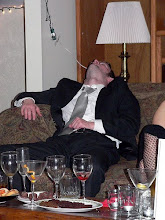 |
| fig. 1: Not Hannibal Lecter |
Plenty of ink both real and digital has been spilled in the thirteen years since The Bourne Identity premiered about the effect it had on the James Bond franchise--as well as action movies in general--and it would be boring for me to rehash it all here. Suffice it to say it was seismic. James Bond had to adapt. He did this by using one of the franchise's longest-used tricks: the appropriation of whatever was popular at the year of the film's release. 2006 was a big year for parkour, Texas Hold 'Em poker, and, of particular note to this film: reboots, and prequels.
 |
| fig 2: I can't tell you how many rounds of Texas Hold 'Em I played during 2006. |
The rules were different for Casino Royale, thanks in part to a fortuitous freeing-up of the rights to adapt the book, the first in Fleming's series of novels about the character. (British copyright law is weird. I'm looking in to it. Definitely for Never Say Never Again.) With the original novel to play with, the producers could claim "back to basics" in a way no other outing could claim to.
Indeed, gone are most of the bells and whistles which so defined the franchise and its numerous descendants. The film's main villain, Le Chiffre, though recognizable as a Bond antagonist through his single moniker and his creepy bleeding eye, is not some would-be world conqueror. He's an embezzler. His stakes are decidedly and in that harrowing torture scene he injects a bit of realpolitik back in to the proceedings. "Even after I slaughtered you and your little girlfriend, your people would still welcome me with open arms," he tells Bond. "Because they need. What I know."
And then Le Chiffre is killed, in a bit of franchise-building to set up the next sequel. In that moment before, however, all this low-fi storytelling pays off. It's hard to imagine James Bond failing when it's a megalomaniac threatening to blow up South Korea, but when it's him alone in a room with a bad guy and a chair and a lenght of rope, where the stakes are only a couple hundred million dollars and whether or not one terrorist goes free, you get the sense that he might actually lose.
This is, to me, the essence of Craig's appeal. Though most of the rough edges of that original interpretation of the character remain, he's fallible and vulnerable in a way that none of his predecessors managed. This is, again, the franchise playing catch-up, this time with a modern storytelling that emphasizes the kind of interiority that James Bond, in his cinematic incarnations at least, never possessed.
When I was growing up, I was sort of aware that James Bond was around and that he'd been played by these different actors. The Roger Moore films were a staple of basic-cable outlets like TBS and the like. Same with Connery. I've seen snippets of both Moonraker, For Your Eyes Only and Never Say Never Again several times out of context. Somehow, Moonraker shook out as the film most likely to be seen randomly about three-quarters of the way through its run, at any given time of day. The first James Bond film I saw in the theater was a Brosnan entry, but not his first. It was Tomorrow Never Dies, which I saw with my brother. So Brosnan was already the incumbent when I saw him on the big screen, and his transformation into a new actor was something that, to date, I had not witnessed.
What a brutal, assured transformation that was. The black-and-white noirish opening, the quick-cut editing, the subversion of the classic gun barrel sequence. For these essays I rewatch a Bond film a week, but for Casino Royale I felt compelled to rewatch the debuts of each of the other actors to play the part. In GoldenEye, you see Brosnan in glimpses: from afar: hair, then eyes, then full-face and a lame quip. In The Living Daylights, a group of mountain climbers, of false leads, a pair of guys who are meant to look more like Bond than Timothy Dalton, red herrings if Dalton's face wasn't all over Daylights' promotional material. Live and Let Die eschews Bond for the entirety of the cold open before cutting to the title song, then a soft-focus shot of a sleeping lady and a pull back to Roger Moore. On Her Majesty's Secret Service delivers that famous fourth-wall-breaking quip. This never happened to the other fella. That said, even with those films, their in-film debut comes after a full-on shot in the opening gun barrel sequence. What's the point in building up your lead in fits and starts if everyone's already seen him take that shot in his tux? The gun barrel subversion, coming at the end of a brutal, violent sequence, is one of the first of Casino Royale's great statements of purpose.
 |
| fig. 3: Funny that Campbell would go on to direct this piece of shit. |
As a series of spy films set at least nominally in the real world, the James Bond franchise has to constantly negotiate that balance between the concerns of the real world and the franchise's own drive to break left and do something completely strange. Bond himself is a fictional character bound by fictional rules and conceits. He works for a real-world organization and a real-world country, based out of a real-world building that, in Spectre, will be demolished because of the actions of a fictional terrorist. More than any other era, the Craig films are about that negotiation between the world of realpolitik and the world of monologuing supervillians and esoteric death traps. These four films represent a long negotiation between James Bond and the world. But to see where they might go next, it is perhaps necessary to keep looking back.




No comments:
Post a Comment